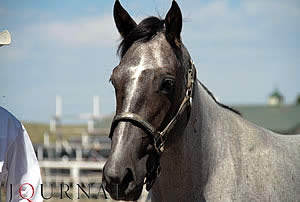Journal photo.
The head is a very delicate area, and many horses show confidence problems when touched here.
By desensitizing this zone, you will make life considerably easier for you and your horse. You will be able to treat his eyes, administer deworming paste, and have him examined by the dentist without any problems. Grooming the mane or clipping the poll and ears will not result in a head-butt, and you will be able to bridle the horse without him becoming defensive.
Once you can stroke all parts of his head, ears, eyes and mouth, you will be able to deal with him much more easily.
Ears: With the horse’s head lowered, run your hand slowly along his neck toward the ears. Then withdraw your hand just before he reacts.
Eyes: To pass your hand across his eyes, start from an area where he accepts your touch. Using a circular movement, gradually approach his eye, taking care to withdraw your hand before he reacts and move it to an area where he appreciates being touched.
Mouth: To touch his mouth, you must start by touching his lips. Gradually insert your finger into his mouth in the gap between his teeth where the bit lies. Bear in mind that you should reward absence of reaction with relaxation and that you must patiently persist if the horse reacts. Make sure the horse has understood that as soon as he accepts something which is in principle unpleasant, it will stop. If he knows he can find your “off switch,” he will accept you more easily.
Horsemanship Concepts:
- The difference between sensitization and desensitization in horses just depends on the moment at which you stop.
- Your horse’s reactions are not personal; they are just natural.
- Do it for the horse, not to him.
Head to AQHA Daily to continue reading about desensitizing your horse.
American Quarter Horse Association
1600 Quarter Horse Drive
Amarillo, TX 79104
